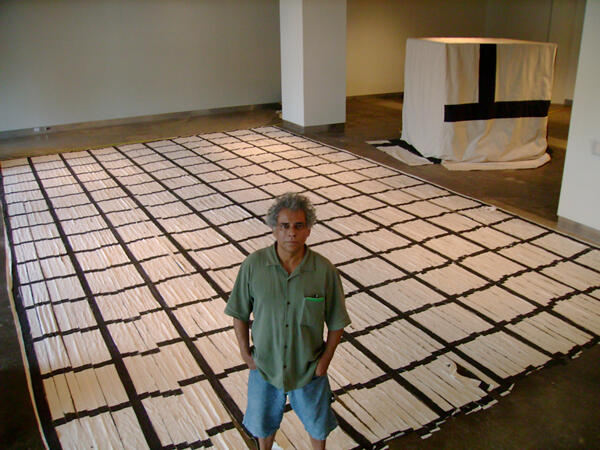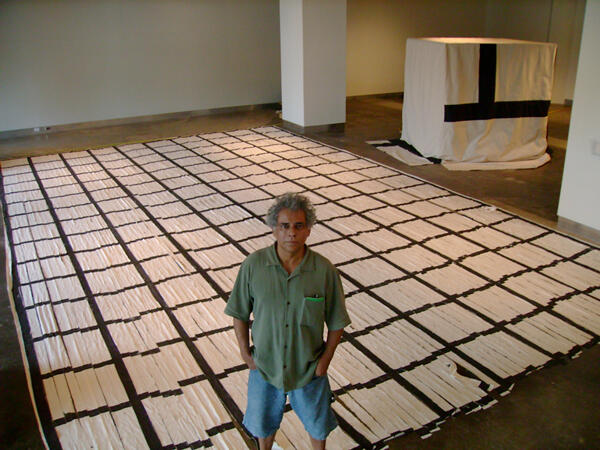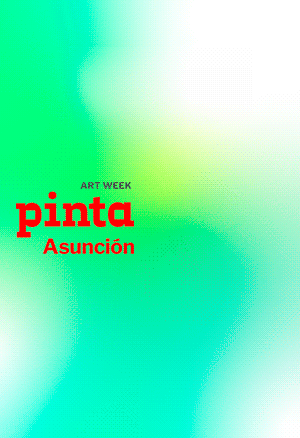Eugenio Espinoza + Andrés Michelena
CCE, Miami
This tandem project was structured through the dialogue of certain bodies of the work of two Venezuelan artists belonging to different generations: Eugenio Espinoza (b. 1950) and Andrés Michelena (b. 1963). But it actually mobilized the thread of continuities and discontinuities that linked together and subverted Modernism in Venezuela, as an echo of the great current along which the 20th century flowed.

The semiotician Roc Laseca articulated this exhibition around three verbs – remember, arrange, resist – that reflect their own construction/deconstruction methodology based on the memory of the failed project of modernity in Venezuela, of the skilful appropriation of space as container of multiple plays on options, and on a teleological probing with regard to discursive resistance.
Absent from this show is Espinoza’s legendary Impenetrable (1972), which in its own way posed contempt or a demystification of Soto’s Penetrables, also subverting with an atypical flexibility the grid, an essential figure – almost a sine qua non condition – of modernism. But the majority of the works exhibited contain the spirit of that resistance.
Espinoza, more aligned with the spirit of Gego’s organic reticles, appropriated at that time the grid that constituted the canon, the great narrative of an art that aspired to undo, through formal purity, any contamination derived from life or its meanings. Suffice it to see the huge canvas of the on-site work The Exhibitionist (2013), hung in the manner of a suit from a hanger against the wall, from which the black lines intercrossing at ninety-degree angles drop down; or to cross the main gallery walking over the canvas featuring the grid in Modern Negative (2006), arranged to be stepped on, to understand the nature of the deconstruction of the grid –to a certain extent, an oppressive memory. Now it is sensually stretched over huge spaces in order to be exposed to the contagion of life.
In turn, Michelena, extends this dialogue with modernism and its deconstruction, which was already present when he began his career, through small-format works and a less iconoclastic – there was nothing less to demolish – and playful attitude.
Many pieces had as point of departure for their construction IKEA furniture – epitome of modernity available to everyone. On the squared surfaces – aligned against the wall or on the floor – the artist painted in acrylic fragments that appeared to be mechanical graphic designs. But seen at close range, those aligned geometric figures in the series Countervision (2013) reveal the “imperfection” of manual work and the vulnerability of the gesture. He also installed the plywood legs as gestures of appropriation of the space, which interact with the square. In Lack Off-2, the square surface appears painted in black and resting on the ground, and the white stripes arranged in incomplete traces form, without touching one another, an intersection, a field activated by the precarious balance of the square and the square’s incomplete line.
Beside a huge hanging grid – a coat one can take off? – by Espinoza, there is another piece by Michelena featuring wooden strips which might have formed a rigid structure, more in keeping with the expectations of the geometric piece, and which instead rest on the ground suggesting other possible forms, a reconstructive potentiality.
Laseca arranged the pieces creating an open work which could contain – and in fact does contain – the body and the memory of many pieces. It faces us with a modernism that is destroyed, rebuilt, transformed into the material for permanent deconstruction, but ultimately, in a playful, open, flexible way. Perhaps after the great narratives what we are left with is the lightness of continual reinvention. The exhibition constituted, in a way, a meditation in the present, the echo of some way of inhabiting it without grandiloquence, but based on the responsibility of reinventing oneself at every instant.






